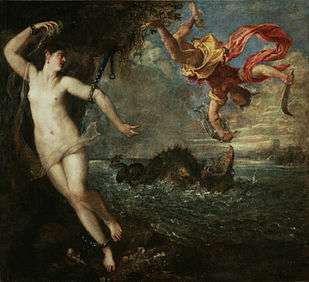Andromeda (mythology)

In Greek mythology, Andromeda is the daughter of the Aethiopian king Cepheus and his wife Cassiopeia. When Cassiopeia's hubris leads her to boast that Andromeda is more beautiful than the Nereids, Poseidon sends a sea monster, Cetus, to ravage Aethiopia as divine punishment.[1] Andromeda is stripped and chained naked to a rock as a sacrifice to sate the monster, but is saved from death by Perseus.
Her name is the Latinized form of the Greek Ἀνδρομέδα (Androméda) or Ἀνδρομέδη (Andromédē): "ruler of men",[2] from ἀνήρ, ἀνδρός (anēr, andrós) "man", and medon, "ruler".
As a subject, Andromeda has been popular in art since classical times; it is one of several Greek myths of a Greek hero's rescue of the intended victim of an archaic hieros gamos (sacred marriage), giving rise to the "princess and dragon" motif. From the Renaissance, interest revived in the original story, typically as derived from Ovid's account.
Mythology
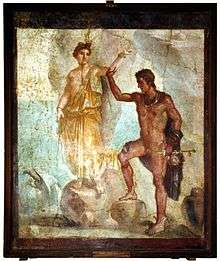
In Greek mythology, Andromeda was the daughter of Cepheus and Cassiopeia, king and queen of the North African kingdom of Aethiopia.
Her mother Cassiopeia boasted that her daughter was more beautiful than the Nereids, the nymph-daughters of the sea god Nereus and often seen accompanying Poseidon. To punish the queen for her arrogance, Poseidon, brother to Zeus and god of the sea, sent a sea monster named Cetus to ravage the coast of Aethiopia including the kingdom of the vain queen. The desperate king consulted the Oracle of Apollo, who announced that no respite would be found until the king sacrificed his daughter, Andromeda, to the monster. Stripped naked, she was chained to a rock on the coast.
Perseus was returning from having slain the Gorgon Medusa. After he happened upon the chained Andromeda, he approached Cetus while invisible (for he was wearing Hades's helm), and killed the sea monster. He set Andromeda free, and married her in spite of her having been previously promised to her uncle Phineus. At the wedding a quarrel took place between the rivals and Phineus was turned to stone by the sight of the Gorgon's head.[3]
Andromeda followed her husband, first to his native island of Serifos, where he rescued his mother Danaë, and then to Tiryns in Argos. Together, they became the ancestors of the family of the Perseidae through the line of their son Perses. Perseus and Andromeda had seven sons: Perses, Alcaeus, Heleus, Mestor, Sthenelus, Electryon, and Cynurus as well as two daughters, Autochthe and Gorgophone. Their descendants ruled Mycenae from Electryon down to Eurystheus, after whom Atreus attained the kingdom, and would also include the great hero Heracles. According to this mythology, Perseus is the ancestor of the Persians.
At the port city of Jaffa (today part of Tel Aviv) an outcrop of rocks near the harbour has been associated with the place of Andromeda's chaining and rescue by the traveler Pausanias, the geographer Strabo and the historian of the Jews Josephus.[4]
After Andromeda's death, as Euripides had promised Athena at the end of his Andromeda, produced in 412 BCE,[5] the goddess placed her among the constellations in the northern sky, near Perseus and Cassiopeia; the constellation Andromeda, so known since antiquity, is named after her.
Constellations
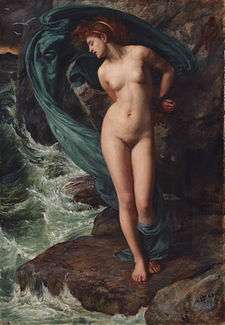
Andromeda is represented in the northern sky by the constellation Andromeda, which contains the Andromeda Galaxy.
Four constellations are associated with the myth. Viewing the fainter stars visible to the naked eye, the constellations are rendered as:
- A huge man wearing a crown, upside down with respect to the ecliptic (the constellation Cepheus)
- A smaller figure, next to the man, sitting on a chair; as it is near the pole star, it may be seen by observers in the Northern Hemisphere through the whole year, although sometimes upside down (the constellation Cassiopeia)
- A maiden, chained up, facing or turning away from the ecliptic (the constellation Andromeda), next to Pegasus
- A whale just under the ecliptic (the constellation Cetus)
Other constellations related to the story are:
- Perseus
- The constellation Pegasus, who was born from the stump of Medusa's neck, after Perseus had decapitated her
- The constellation Pisces, which may have been treated as two fish caught by Dictys the fisherman who was brother of Polydectes, king of Seriphos, the place where Perseus and his mother Danaë were stranded
Perseus and Andromeda in art
Sophocles and Euripides (and in more modern times, Corneille) made the story the subject of tragedies, and its incidents were represented in numerous ancient works of art, including Greek vases. Jean-Baptiste Lully's opera, Persée, also dramatizes the myth.
Andromeda has been the subject of numerous ancient and modern works of art, which typically show the moment of rescue, with Andromeda usually still chained, and often naked or nearly so. Examples include: one of Titian's poesies (Wallace Collection), and compositions by Joachim Wtewael (Louvre), Veronese (Rennes), many versions by Rubens, Ingres, and Gustave Moreau. From the Renaissance onward the chained nude figure of Andromeda typically was the centre of interest. Rembrandt's Andromeda Chained to the Rocks is unusual in showing her alone, fearfully awaiting the monster.
If by dull rhymes our English must be chain’d,
And, like Andromeda, the Sonnet sweet
Fetter’d, in spite of pained loveliness;
Let us find out, if we must be constrain’d,
Sandals more interwoven and complete
To fit the naked foot of poesy;
Let us inspect the lyre, and weigh the stress
Of every chord, and see what may be gain’d
By ear industrious, and attention meet:
Misers of sound and syllable, no less
Than Midas of his coinage, let us be
Jealous of dead leaves in the bay wreath crown;
So, if we may not let the Muse be free,
She will be bound with garlands of her own.
"If by Dull Rhymes Our English Must Be Chain'd"
John Keats (1795–1821)[6]
The Italian composer Salvatore Sciarrino composed an hour-long operatic drama called Perseo e Andromeda in 2000.
Film
In 1973, an animated film called Perseus (20 minutes) was made in the Soviet Union as part of the Soviet animated film collection called Legends and Mуths of Ancient Greece.[7][8]
The 1981 film Clash of the Titans retells the story of Perseus, Andromeda, and Cassiopeia, but makes a few changes (notably Cassiopeia boasts that her daughter is more beautiful than Thetis as opposed to the Nereids as a group). Thetis was indeed a Nereid and also the future mother of Achilles. Andromeda and Perseus meet and fall in love after he saves her soul from the enslavement of Thetis' son, Calibos, whereas in the myth, they simply meet as Perseus returns home from having slain Medusa. In the film, the monster is called a kraken, although it is depicted as a lizard-like creature rather than a squid; and combining two elements of the myth, Perseus defeats the sea monster by showing it Medusa's face, turning the monster into stone. Andromeda is depicted as being strong-willed and independent, whereas in the stories she is only really mentioned as being the princess whom Perseus saves from the sea monster. Andromeda was portrayed by Judi Bowker in this film.
Andromeda also features in the 2010 film Clash of the Titans, a remake of the 1981 version. Several changes were made in regard to the myth, most notably that Perseus did not marry Andromeda after he rescued her from the sea monster. Andromeda was portrayed by Alexa Davalos. The character was played by Rosamund Pike in the sequel Wrath of the Titans, the second of a planned trilogy. In the end of the sequel, Perseus and Andromeda begin a relationship.
In the Japanese anime Saint Seiya the character, Shun, represents the Andromeda constellation using chains as his main weapons, reminiscent of Andromeda being chained before she was saved by Perseus. In order to attain the Andromeda Cloth, he was chained between two large pillars of rock and he had to overcome the chains before the tide came in and killed him, also reminiscent of this myth.
Andromeda appears in Disney's Hercules: The Animated Series as a new student of "Prometheus Academy" which Hercules and other characters from Greek mythology attend.
Novels
In Rick Riordan's Percy Jackson & the Olympians series, there are a few references to Andromeda. The most obvious is that the series' lead villains have a cruise ship which serves as their headquarters and is called The Princess Andromeda.
Andromeda is the main character in Harry Turtledove's short story "Miss Manners' Guide to Greek Missology", published in Esther Friesner's Chicks in Chainmail series of humorous feminist fantasy collections, and reprinted in other anthologies afterwards. It is a satire filled with role reversals, puns, and deliberate anachronisms relating to pop culture.
Andromeda is Anna's full name in Jodi Picoult's My Sister's Keeper, which was turned into a movie in 2010. In the novel there are several references to mythology, as Anna's dad Brian is an astronomer in his free time.
Depictions in art
- Andromeda in art
-
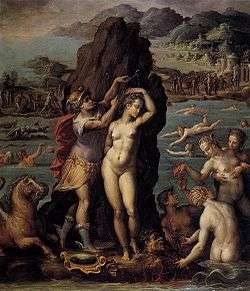
Giorgio Vasari, Perseus and Andromeda, 1570
-
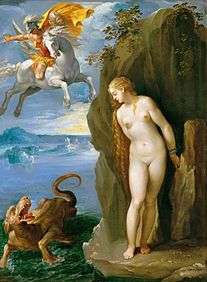
Painting by Giuseppe Cesari (1568–1640)
-

Joachim Wtewael, Louvre
-

Andromeda Chained to the Rocks, Rembrandt (1630)
-

Andromeda by Rubens
-
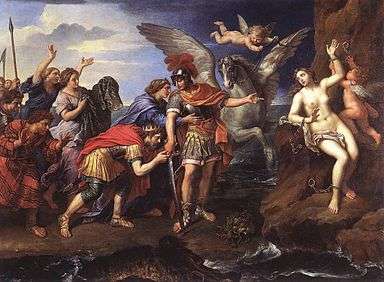
Andromeda's parents thank Perseus for freeing her; La Délivrance d'Andromède (1679) Pierre Mignard
-
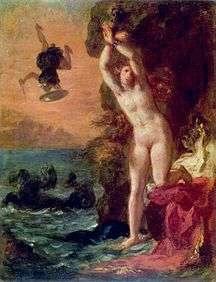
Painting by Eugène Delacroix
-

Andromeda Chained to the Rock by the Nereids (1840) by Théodore Chassériau
-
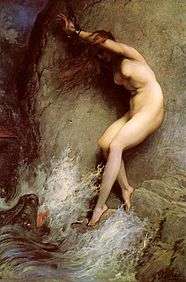
Andromeda (1869) by Paul Gustave Doré
-

A sculpture of Andromeda by Domenico Guidi
-

Painting by Edward Burne-Jones
See also
Sources
- Bibliotheca II, iv, 3–5.
- Edith Hamilton, Mythology, Part Three, 204–207.
- Ovid, Metamorphoses IV, 668–764.
References
- ↑ Who's Who in Classical Mythology, Michael Grant & John Hazel, Oxford University Press, 1973, 1993, p. 31, ISBN 0-19-521030-1.
- ↑ The traditional etymology of the name is, "she who has bravery in her mind"
- ↑ Ovid, Metamorphoses v. 1.
- ↑ Pausanias iv.35.9; Strabo xvi.2.28; Josephus, Jewish War iii.9.3
- ↑ Karl Kerenyi, The Heroes of the Greeks 1959:53; Euripides' drama is lost, save some fragments.
- ↑ "If by Dull Rhymes Our English Must Be Chain'd". Poetry Foundation. Retrieved 7 September 2015.
- ↑ "тПУУЙКУЛБС БОЙНБГЙС Ч ВХЛЧБИ Й ЖЙЗХТБИ - жЙМШНЩ - "ретуек"". animator.ru. Retrieved 7 September 2015.
- ↑ "КиноПоиск.ru - Все фильмы планеты". kinopoisk.ru. Retrieved 7 September 2015.
External links
| Wikimedia Commons has media related to Andromeda. |
- "Andromeda", Encyclopædia Britannica, 9th ed., Vol. II, New York: Charles Scribner's Sons, 1878.
- "Andromeda", Encyclopædia Britannica, 11th ed., Vol. I, Cambridge: Cambridge University Press, 1911.
